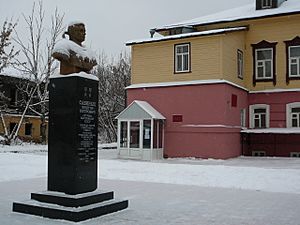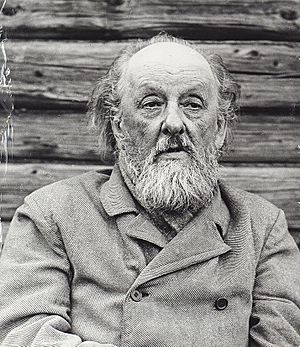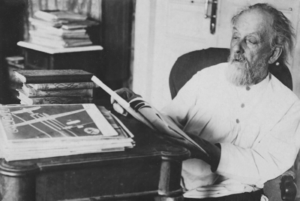Konstantin Tsiolkovsky facts for kids
Quick facts for kids
Konstantin Eduardovich Tsiolkovsky
|
|
|---|---|
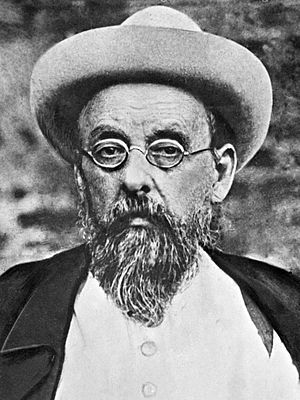 |
|
| Born | 17 September [O.S. 5 September] 1857 Izhevskoye, Ryazan Governorate, Russian Empire
|
| Died | 19 September 1935 (aged 78) Kaluga, Russian SFSR, Soviet Union
|
| Nationality | Russian |
| Known for | Tsiolkovsky's rocket equation |
| Scientific career | |
| Fields | Astronautic theory |
Konstantin Eduardovich Tsiolkovsky (born September 17, 1857 – died September 19, 1935) was a Russian scientist. He was a pioneer in rocket science and the theory of astronautics. He is seen as one of the main founders of modern rocketry and space travel. Other founders include Robert Esnault-Pelterie from France, Hermann Oberth from Germany, and Robert H. Goddard from America.
Tsiolkovsky's ideas later inspired important Soviet rocket engineers. These included Sergei Korolev and Valentin Glushko. His work helped make the Soviet space program successful.
In 1903, he wrote a key study called Means of Reaction Devices. This was the first serious look at how to use rockets to launch spacecraft. He figured out the speed needed to reach orbit around Earth, which is about 8 kilometers per second. He also suggested that a multi-stage rocket, using liquid fuel, could reach this speed. He recommended liquid hydrogen and liquid oxygen as fuels. He was correct about these important points.
Tsiolkovsky lived most of his life in a log house in Kaluga, Russia. This town is about 200 kilometers (124 miles) southwest of Moscow. He was a quiet person and his habits made him seem a bit strange to others in his town.
Contents
Early Life and Learning
Konstantin Tsiolkovsky was born into a middle-class family in Izhevskoye, Russian Empire. His father was a Polish forester. His mother was of mixed Russian and Tatar background. His father worked as a forester, a teacher, and a government official.
When Konstantin was 10, he got scarlet fever. This illness caused him to become hard of hearing. Because of his hearing problem, he could not go to elementary school. So, he taught himself at home. As a quiet child who learned at home, he spent a lot of time reading books. He became very interested in mathematics and physics. As a teenager, he started thinking about the idea of space travel.
Tsiolkovsky spent three years at a library in Moscow. There, he met Nikolai Fyodorovich Fyodorov, who supported Russian cosmism. Tsiolkovsky later believed that living in space would help humans become perfect. He thought it could lead to immortality and a life without worries.
Inspired by the stories of Jules Verne, Tsiolkovsky developed many ideas about space travel. He also thought about how rockets could move through space. He is known as the father of spaceflight. He was also the first person to imagine a space elevator. He got this idea in 1895 after seeing the new Eiffel Tower in Paris.
After his studies, Tsiolkovsky passed a teacher's exam. He then began working at a school in Borovsk, near Moscow. During this time, he also met and married Varvara Sokolova. Even though he lived in a small town far from big learning centers, Tsiolkovsky made important scientific discoveries on his own.
Key Scientific Discoveries
Tsiolkovsky said he developed his rocket theories to support his philosophical ideas. He wrote over 400 works, with about 90 published pieces on space travel. His ideas included designs for rockets with steering parts and multi-stage boosters. He also thought about space stations and airlocks for leaving a spaceship. He even designed systems to provide food and oxygen for space colonies.
Tsiolkovsky's first scientific study was in 1880–1881. It was called "The Mechanics of the Animal Organism" and received good reviews. After 1884, his main work focused on four areas. These were all-metal balloons (airships), streamlined airplanes and trains, hovercraft, and rockets for travel between planets.
Tsiolkovsky set up Russia's first aerodynamics lab in his apartment. In 1897, he built the first Russian wind tunnel. He also created a new way to experiment using it. Tsiolkovsky's work in aerodynamics gave ideas to Nikolay Zhukovsky, who is known as the father of modern aerodynamics.
On May 10, 1897, Tsiolkovsky wrote down his famous rocket equation. This formula describes how a body with changing mass moves. The same year, Russian mathematician Ivan Meshchersky also published a similar formula.
His most important work came out in May 1903. It was called Exploration of Outer Space by Means of Rocket Devices. The look of Tsiolkovsky's spacecraft design from 1903 became the basis for modern spaceship designs. His design had a body divided into three main parts. The pilot and copilot were in the first part. The second and third parts held the liquid oxygen and liquid hydrogen needed for fuel.
Tsiolkovsky came up with many ideas that are now used in rockets. These include:
- Gas rudders (made of graphite) to control a rocket's flight.
- Using fuel parts to cool the outside of the spacecraft when it returns to Earth.
- Using fuel parts to cool the walls of the engine's combustion chamber and nozzle.
- A pump system to feed the fuel into the engine.
- The best path for a spacecraft to take when returning from space.
Tsiolkovsky believed there was life all over the universe. He was also the first person to suggest and support the idea of human spaceflight.
Tsiolkovsky never actually built a rocket. He did not seem to expect many of his theories to be built during his lifetime.
Even with his hearing problems, Tsiolkovsky understood music well. He wrote about this in his work "The Origin of Music and Its Essence."
Later Life and Passing
Tsiolkovsky supported the new Soviet government after the October Revolution. In 1918, the government elected him a member of the Socialist Academy. He worked as a high school mathematics teacher until he retired in 1920 at age 63. In 1921, he started receiving a pension for life.
Only later in his life did Tsiolkovsky get recognition for his important work. From the mid-1920s, his work was acknowledged. The Soviet government gave him money to support his research.
Tsiolkovsky passed away in Kaluga on September 19, 1935. He had surgery for stomach cancer. He gave all his life's work to the Soviet Union.
Legacy and Influence
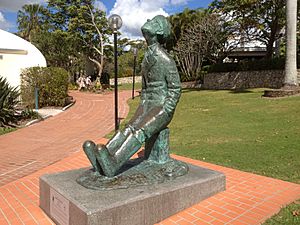
Many people thought Tsiolkovsky's ideas were not practical. However, he greatly influenced later rocket scientists across Europe. Leading Soviet rocket designers, Valentin Glushko and Sergei Korolev, studied Tsiolkovsky's writings when they were young. Both of them worked to make Tsiolkovsky's theories real. Korolev especially saw traveling to Mars as very important.
In 1928, Tsiolkovsky wrote a book called The Will of the Universe. The Unknown Intelligence. In it, he shared his theory of panpsychism, which suggests that everything has a mind or consciousness. He believed humans would eventually colonize the Milky Way galaxy. His ideas came many decades before the Space Age. Some of what he imagined has come true since his death.
In 1989, Tsiolkovsky was honored. He was added to the International Air & Space Hall of Fame at the San Diego Air & Space Museum.
Images for kids
See also
 In Spanish: Konstantín Tsiolkovski para niños
In Spanish: Konstantín Tsiolkovski para niños


